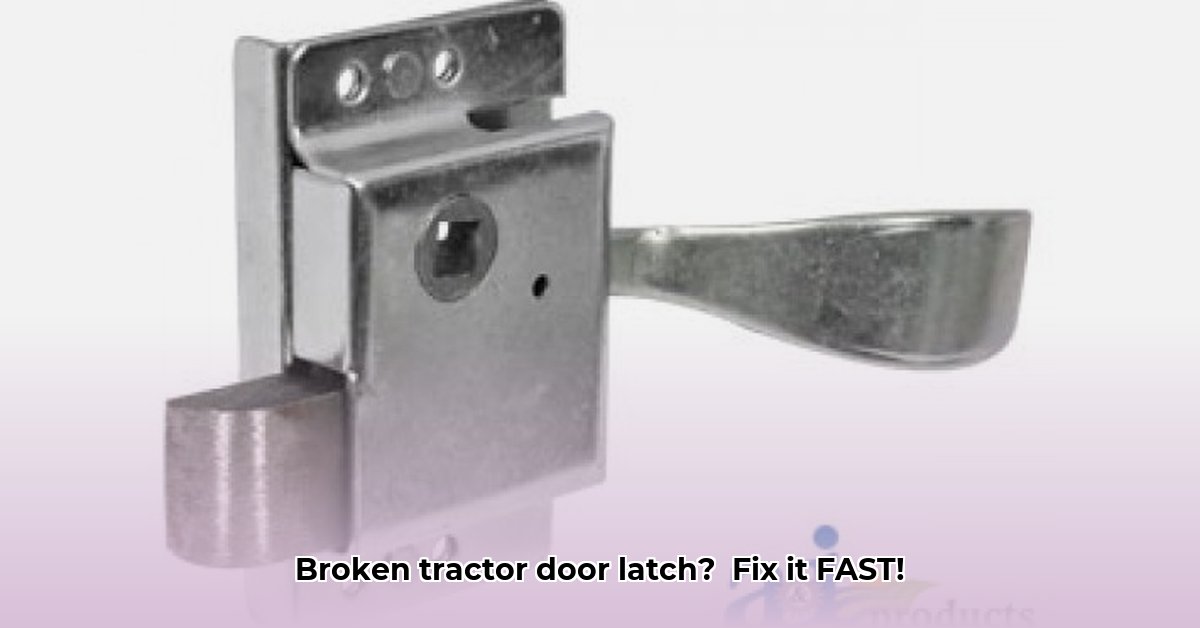
Tractor door latches: small parts, big impact. A malfunctioning latch isn't just inconvenient; it's a safety hazard. This guide provides step-by-step instructions to diagnose, repair, and maintain your tractor's door latch, ensuring smooth operation and preventing costly downtime. For more complex tractor repairs, see our guide on tractor repair.
Identifying Your Tractor's Latch: A Comprehensive Guide
Finding the correct replacement latch can be challenging due to inconsistent part numbering across manufacturers. Begin by consulting your tractor's owner's manual for the correct part number. If unavailable, carefully examine the existing latch. Note its size, shape, material, and any identifying markings. Take clear photos from multiple angles.
Here's a table summarizing common latch types:
| Latch Type | Description | Common Tractor Brands |
|---|---|---|
| Standard Hook & Eye | Simple hook-and-eye mechanism. | Most brands |
| Push-Button Latch | Button activates a release mechanism. | Many brands, especially older models |
| Locking Latch | Includes a key or combination lock for enhanced security. | John Deere, Case IH, and others |
| Spring-Loaded Latch | Automatically closes after opening. | New Holland, Massey Ferguson, and other modern tractors |
| Multiple-Bolt Latch | Uses multiple bolts for enhanced security (often found on heavy-duty tractors). | Often found on heavy-duty or industrial tractors |
Remember, accurate identification is crucial for selecting the correct replacement. Don't hesitate to contact your local parts supplier with photos for assistance. How often do you find yourself struggling with inconsistent part numbers?
Choosing the Right Replacement Latch: OEM vs. Aftermarket
You have two primary choices: Original Equipment Manufacturer (OEM) parts or aftermarket parts. OEM latches, sourced directly from the tractor manufacturer, typically offer superior quality, durability, and precise fit. However, they often command a higher price.
Aftermarket latches provide a more budget-friendly alternative. However, quality can vary significantly. Always check reviews before purchasing to avoid inferior materials and substandard construction. A poorly constructed latch could lead to premature failure, posing a safety risk.
Consider these factors:
| Feature | OEM Latch | Aftermarket Latch |
|---|---|---|
| Quality | Superior; designed for precise fit and longevity. | Variable; requires careful selection and review. |
| Cost | Higher | Lower |
| Warranty | Typically covered by manufacturer’s warranty. | Warranty varies; may have no warranty. |
| Availability | Readily available from authorized dealers. | May require more extensive searching. |
Which type of latch offers the best balance of cost and reliability for your needs?
Installing Your New Latch: A Step-by-Step Guide
Safety First: Always disconnect the tractor's battery before beginning any repairs.
- Remove the Old Latch: Carefully disassemble the old latch, taking photos as you go. Pay close attention to the latch's orientation and the sequence of removal.
- Prepare the New Latch: Inspect the new latch for any defects.
- Install the New Latch: Align the new latch according to instructions and photos. Ensure that all components are correctly aligned and securely fastened.
- Test the Latch: Thoroughly test the latch multiple times, opening and closing the door to confirm smooth, reliable operation.
- Reconnect the Battery: Once satisfied, reconnect the tractor's battery.
Troubleshooting Common Issues: Addressing Malfunctions
Addressing common problems quickly ensures safety and minimal downtime.
- Latch Doesn't Engage Fully: Check for misalignment, debris, or broken parts. Clean and lubricate as necessary.
- Stiff or Difficult Latch: Apply an appropriate lubricant to improve latch movement.
- Latch Won't Close: Verify proper alignment and inspect for broken components. Replacement may be necessary.
Remember, a malfunctioning latch is a safety hazard. Address any issues promptly.
Maintaining Your Tractor Door Latch: Preventative Care
Preventative maintenance extends the lifespan of your latch and ensures continued safe operation.
- Regular Inspection: Regularly check for wear, tear, and damage.
- Cleaning: Clean the latch mechanisms regularly to remove debris that could hinder operation.
- Lubrication: Apply a thin layer of suitable lubricant to moving parts to ensure smooth operation.
Resources and Further Reading
Your tractor's owner's manual is your first and best resource. Supplement this with parts catalogs from your local dealer or online agricultural equipment suppliers. Always cross-reference part numbers to ensure accuracy.
By following this guide, you can effectively address tractor door latch problems, restoring functionality and ensuring the safety and reliability of your equipment.